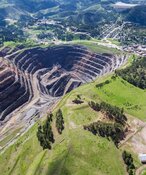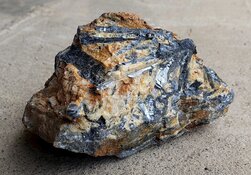The Life Cycle of a Gold Mine: Assessment and Approval
Source: Leia Toovey, Gold Investing News (9/9/11)
"The goal of the assessment phase is to thoroughly investigate how mining will impact the environment and communities, and how the miner will mitigate the risks associated with resource extraction."
Regardless of how valuable of a resource an exploration company discovers, the resource will never be brought to market unless the company can properly assess and present the total environmental and socioeconomic impacts of going from buried resource, to mine, to reclaimed land. The goal of the assessment phase is to thoroughly investigate how mining will impact the environment and communities, and how the miner will mitigate the risks associated with resource extraction. Not only must a miner conduct an accurate assessment of the risks and benefits of mining, they must communicate their assessments to various government agencies, and have these agencies agree that the pros of developing a mine outweigh the cons, before they will be granted permission to develop a mine.
Financial considerations are very important in the assessment phase as environmental preservation and remediation come at a financial cost, and in environmentally sensitive areas the cost of preservation and remediation may render a proposed mine uneconomic. Development must limit impacts to the environment and bring social and economic benefits to the mining company, local communities, and the local economy before a government will approve a mine's development.
Mining is overseen by governments, therefore, the precise steps involved in the assessment phase depend on the government in the country/state/province where the mine is to be constructed. The assessment phase is extremely complex. Exploration companies can expect to fill out hundreds of pages of paperwork, apply for dozens of permits, and share data collected since preliminary exploration work.
In this piece we will address the basics of the assessment process, as this phase will vary considerable depending on the local government, the type of proposed mine, the location of the mine, etc. The prudent investor should educate themselves on the "mining friendliness" of the region where an exploration stage company is interested in mining to see how often proposals are outright objected, or held up by "red tape."
Permitting
The entire life cycle of a mine is laden with permits. Explorers must get permits to explore a piece a land, permits to extract resources from a land, permits to construct a mine, etc. The length of time it takes to obtain the necessary permits to build a mine depends on the country where the proposed mine is to be located. The United States has one of the longest permitting phases; obtaining approval takes an average of seven years. On the other side of the scale, the approval process in Australia takes an average of one to two years. In the permitting phase, the mining company will present to the required agencies a comprehensive document that outlines the proposed impacts, and how these impacts can be mitigated. The nomenclature of this document depends on the country, but is commonly referred to as an Environmental Impact Study.
The Environmental Impact Study
An Environmental Impact Study (EIS) must be completed before a miner can receive approval to build a mine. The EIS addresses the possible environmental, economic and social impacts, both positive and negative, that would result from mining the discovered gold resource. In the environmental impact assessment, all potential impacts are addressed, including, but not limited to: impacts on wildlife, aquatic and terrestrial habitats, socio-economics (disruptions to local communities including first nations land), noise, air and water pollution, and hydrogeology. In the end, the EIS has to show that the benefits of building the mine outweigh all the possible negatives, or the government is unlikely to grant permission for mine construction. The EIS is disclosed to agencies involved in making decisions on the project. Whether or not a company is granted a permit (a go-ahead) on a project is dependent on the information contained in the EIS. If all or parts of the EIS are rejected, the proposer is usually given a chance to make adjustments, and reapply.
Reclamation
Reclamation is a separate phase in the lifecycle of a mine; however, it is an important consideration during the assessment and approval phase because this is when an exploration company will first start considering the reclamation process. In the process of obtaining approval to build a mine, exploration companies must address how they will reclaim the land after mining has finished. Governments are extremely interested, and therefore pay close attention, to a mining company's reclamation plan. The cost estimate to perform the reclamation is provided by the miner in a Mining and Reclamation Plan. Many governments require a mining company to provide some form of collateral towards reclamation before then can go forward with mining. This collateral may be a cash deposit, a bond, or a letter of credit from a lending institution. It is up to the government what they consider an acceptable deposit. Reclamation will be addressed, more in depth, in a latter part of this life cycle of a mine series.
Financial considerations
In order to build a mine, the mineral deposit must be valuable enough to cover the costs of design and construction (capital costs), mine operation (operating costs), and mine closure and reclamation. In the feasibility study, financial considerations were important to determine if it was "worth" extracting a mineral reserve. In the assessment phase, exploration companies will take a more in depth look at other financial considerations involved in the operating and reclamation phases.
Miners are interested in making money, and governments are interested in ensuring that their mineral resources are utilized in a responsible and sustainable manner for the benefit of the Crown and the people. The assessment phase is an in-depth phase that involves close communication between the miners and government agencies. That all stake holders make sure that their needs and requirements are addressed is imperative during the assessment phase. Mining companies will spend a great deal of money and time determining and communicating the pros and cons of a potential mining development. While the assessment phase may seem tedious to an investor, it also provides a sense of security. When a miner obtains approval to go-ahead, an investor can be more confident that the risks inherent in mine development have been thoroughly addressed. -Gold Investing News
Financial considerations are very important in the assessment phase as environmental preservation and remediation come at a financial cost, and in environmentally sensitive areas the cost of preservation and remediation may render a proposed mine uneconomic. Development must limit impacts to the environment and bring social and economic benefits to the mining company, local communities, and the local economy before a government will approve a mine's development.
Mining is overseen by governments, therefore, the precise steps involved in the assessment phase depend on the government in the country/state/province where the mine is to be constructed. The assessment phase is extremely complex. Exploration companies can expect to fill out hundreds of pages of paperwork, apply for dozens of permits, and share data collected since preliminary exploration work.
In this piece we will address the basics of the assessment process, as this phase will vary considerable depending on the local government, the type of proposed mine, the location of the mine, etc. The prudent investor should educate themselves on the "mining friendliness" of the region where an exploration stage company is interested in mining to see how often proposals are outright objected, or held up by "red tape."
Permitting
The entire life cycle of a mine is laden with permits. Explorers must get permits to explore a piece a land, permits to extract resources from a land, permits to construct a mine, etc. The length of time it takes to obtain the necessary permits to build a mine depends on the country where the proposed mine is to be located. The United States has one of the longest permitting phases; obtaining approval takes an average of seven years. On the other side of the scale, the approval process in Australia takes an average of one to two years. In the permitting phase, the mining company will present to the required agencies a comprehensive document that outlines the proposed impacts, and how these impacts can be mitigated. The nomenclature of this document depends on the country, but is commonly referred to as an Environmental Impact Study.
The Environmental Impact Study
An Environmental Impact Study (EIS) must be completed before a miner can receive approval to build a mine. The EIS addresses the possible environmental, economic and social impacts, both positive and negative, that would result from mining the discovered gold resource. In the environmental impact assessment, all potential impacts are addressed, including, but not limited to: impacts on wildlife, aquatic and terrestrial habitats, socio-economics (disruptions to local communities including first nations land), noise, air and water pollution, and hydrogeology. In the end, the EIS has to show that the benefits of building the mine outweigh all the possible negatives, or the government is unlikely to grant permission for mine construction. The EIS is disclosed to agencies involved in making decisions on the project. Whether or not a company is granted a permit (a go-ahead) on a project is dependent on the information contained in the EIS. If all or parts of the EIS are rejected, the proposer is usually given a chance to make adjustments, and reapply.
Reclamation
Reclamation is a separate phase in the lifecycle of a mine; however, it is an important consideration during the assessment and approval phase because this is when an exploration company will first start considering the reclamation process. In the process of obtaining approval to build a mine, exploration companies must address how they will reclaim the land after mining has finished. Governments are extremely interested, and therefore pay close attention, to a mining company's reclamation plan. The cost estimate to perform the reclamation is provided by the miner in a Mining and Reclamation Plan. Many governments require a mining company to provide some form of collateral towards reclamation before then can go forward with mining. This collateral may be a cash deposit, a bond, or a letter of credit from a lending institution. It is up to the government what they consider an acceptable deposit. Reclamation will be addressed, more in depth, in a latter part of this life cycle of a mine series.
Financial considerations
In order to build a mine, the mineral deposit must be valuable enough to cover the costs of design and construction (capital costs), mine operation (operating costs), and mine closure and reclamation. In the feasibility study, financial considerations were important to determine if it was "worth" extracting a mineral reserve. In the assessment phase, exploration companies will take a more in depth look at other financial considerations involved in the operating and reclamation phases.
Miners are interested in making money, and governments are interested in ensuring that their mineral resources are utilized in a responsible and sustainable manner for the benefit of the Crown and the people. The assessment phase is an in-depth phase that involves close communication between the miners and government agencies. That all stake holders make sure that their needs and requirements are addressed is imperative during the assessment phase. Mining companies will spend a great deal of money and time determining and communicating the pros and cons of a potential mining development. While the assessment phase may seem tedious to an investor, it also provides a sense of security. When a miner obtains approval to go-ahead, an investor can be more confident that the risks inherent in mine development have been thoroughly addressed. -Gold Investing News



































